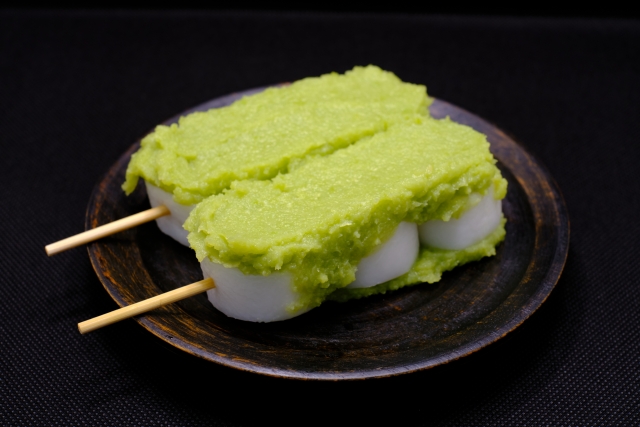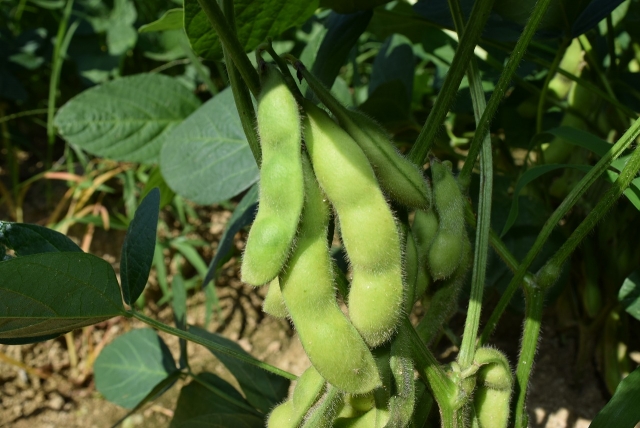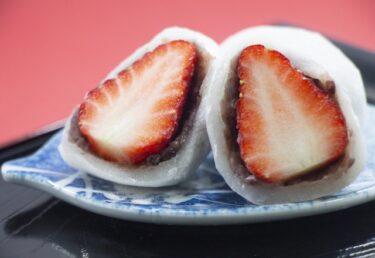Edamame is immature soybeans that have a bright green color.
Boil the pods in salt water and eat them as they are, or you can use them as a raw material for sweet bean paste called “Zunda”.

Boiled food is usually eaten as a side dish when drinking beer, not as a side dish of rice. Edamame is harvested in the hot summer months, so it could only be eaten in the summer, but now that we have frozen foods, we can eat it at any time of the year.
What is Edamame and can I eat it?
Materials of boiled Edamame
Soy beans, salt
| Gluten-free | Low-gluten | Wheat-free | Low FODMAPs | |
| for Vegetarian |
| Food supermarket | Convenience store |
Edamame was only eaten in summer in the old days
Edamame harvested from immature soybeans along with the branches and sold in the form of branches with pods and leaves, or in the form of pods only. Since it is raw, it cannot be stored for a long time and must be boiled in salt immediately after purchase. It is placed in a pod and served on a plate.

Press the pods with your hands and eat only the beans inside. The color of the beans is light green, it is very soft and you can feel the taste of soybeans. Since it is boiled in salt water, it has a salty taste.
Edamame could only be eaten in the summer because it couldn’t be preserved in the past. Now the boiled Edamame can be stored frozen for a long time, so we can eat it all year round.
Frozen foods are available at food supermarkets and convenience stores, and you can taste freshly boiled green soybeans just by heating them in a microwave for a few minutes. Some products can be eaten by thawing with water.

Soybeans can be eaten all over the world, but not many countries boil and eat immature beans. Edamame is eaten in China, Taiwan, Vietnam, and Thailand, but it is said that it originally spread from Japan. We have been eating edamame in Japan for 1300 years.
Edamame is basically boiled and eaten, but in the Tohoku region, boiled edamame is used as a raw material to make bean paste jam called “Zunda”. Since the bean paste jam is often made from azuki beans, it has a brown color, but the zunda has a bright green color. There are also snacks made with Edamame.
Try to eat Edamame!
How much ?
- $ 3~4, Boiled Edamame at Izakaya restaurants.
- $ 2~4, Edamame 400g of frozen food, for 4 peoples.
Where can I eat Edamame ?
You can available at Izakaya restaurants and beer restaurants.
It may not be available in ordinary restaurants.
Frozen foods are available at almost every food supermarket and convenience store.

Precautions when eating Edamame
Everyone can eat Edamame with confidence, except for those who are allergic to soybeans.
Japanese writer’s comment for Edamame
Did you know that there are different types of Edamame? Here are some Edamame that can only be eaten in Japan.
Dadacha-mame
A soybean variety cultivated for green soybeans, which has been cultivated in the Shonai region of Yamagata prefecture for 300 years.
Compared to ordinary Edamame, it has a rich taste, strong sweetness and aroma. Also, the pod hair is brown. Since it is difficult to cultivate and store, the distribution volume is small, but if you are lucky, you can eat it at an izakaya restaurant in Tokyo.
Some enthusiasts order from local vendors by mail order. I have eaten it several times, but it has a rich and creamy taste compared to ordinary edamame.
Kuro-edamame (Black edamame)
It is one of the soybean varieties and is called black soybean because the seed coat is black.
Black soybeans are mainly used as a material for simmered dishes, but the edamame of these black soybeans has a good reputation. Immature black beans have a color that is a mixture of green and purple.
Also, like edamame, which is usually pods, it has a little purple color instead of a perfect green color. The varieties cultivated in the Tanba region, which straddles Hyogo and Kyoto prefectures, have a reputation for having large grains and delicious taste.
It has a richer taste than Dadacha beans and does not smell green. Unlike other green soybeans, this black green soybean is harvested in October and is only available in stores during this time. The distribution volume is small and it is extremely difficult to obtain. If you can eat it, you’re pretty lucky.



